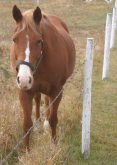Alberta Beef Producers hopes work done with Alberta Financial Services Corp. will see changes made next year
INNISFAIL, Alta. — A new and improved forage and pasture insurance program is needed for Alberta livestock producers.
Alberta Beef Producers formed a special committee this summer to assess the current drought impacts and if government assistance was needed for affected areas.
No specific government aid is coming but after working with Alberta Financial Services Corp., changes could be made to forage insurance starting next year, said ABP chair Charlie Christie in an interview.
Forage and pasture insurance has not been satisfactory, he said at a beef producers zone meeting held in Innisfail Oct. 24.
Read Also

Beef check-off collection system aligns across the country
A single and aligned check-off collection system based on where producers live makes the system equal said Chad Ross, Saskatchewan Cattle Association chair.
“It doesn’t react to what volatile feed prices are. There is a component to react to the volatility but it is not sensitive enough. It needs to change,” he said.
Drought is nothing new for western producers but this year dry conditions stretched across the country, forcing some management decisions like culling cows or weaning calves earlier.
There is going to be a feed shortage so producers must take inventory now, said Barry Yaremcio, forage specialist with Alberta Agriculture.
It is important to know how many bales are on hand and how many head need feed this winter.
“They (producers) have to know the feed quality so they can develop a balanced ration to utilize the lower quality feeds when the cow is pregnant, saving the hay and silage until after calving, then we should be able to do OK,” he said
Early weaned calves can take some pressure off the cows.
“Early weaning reduces the nutrient requirements of the cow by 25 percent compared to when she is lactating,” he said.
If calves are weaned earlier, cows may be able to gain some weight going into winter.
“If she is 200 pounds lighter than what she should be, which is a body condition score change of three to two, you are going to need an extra 1,400 lb. of hay just to keep that animal warm, not to gain weight,” he said.
Swath grazing has started two months earlier because the pastures are gone and more people are considering adding more straw to rations.
Straw quality should be acceptable this fall. However, two-year-old straw is more acceptable to cows to consume free choice.
A straw-grain ration is acceptable up to about two weeks before calving but supplements like protein, magnesium and calcium need to be added.
A lot of grain was harvested at 16 to 18 percent moisture before snow fell in many areas in September, so sprouted barley and wheat could be available.
Some people have baled forages that were tough. Those bales are starting to show signs of heating and deterioration. The bales may smell like tobacco or turn brown.
“Feed it to the cows now when their nutrient requirements are the lowest,” Yaremcio said.
Some people have three or four-year-old hay but the nutritive quality goes down with time so it should be retested. Soluble protein and carbohydrates could be gone and vitamins A and E oxidize and disappear. Digestibility of old forage also drops about 10 percent per year.
“After three or four years, if the bales have been sitting outside in the weather, the feeding value could be no better than straw,” said Yaremcio.
In addition, this year’s hay crop may contain lower protein because of growing conditions and smoke from forest fires this summer blocked the sun’s rays needed for photosynthesis. Those smoky skies stopped the development of some crops and reduced the protein set.
If the weather stays warm this winter and animal maintenance requirements are lower, poor quality hay could be fed early in the year, which may reduce the demand for winter feed.
“If you run out of feed in February, March or April this year, I don’t know how you are going to find feed to bring in at that time of year,” he said.
Letting the cows get thin may not be the best advice.
“It is OK to let the cows lose a little bit of weight, maybe 50 to 100 lb.,” he said.
Greater weight losses affect their health and ability to reproduce. They need to gain weight before calving because otherwise they lose milk production and it takes longer to come back into estrus. A cow in lower body condition score takes 25 percent longer to start cycling again compared to a cow in good condition.
“You are not feeding the calf that is in utero right now. You are feeding that cow, so she has the ability to milk and have high reproductive capabilities in the breeding season next year,” he said.
Alberta Agriculture is posting feed calculators on its website.
Producers can enter feed test results and can offer calculations and show potential problems with individual feed.
More feed calculator resources should be posted soon.
For more information, visit www.agric.gov.ab.ca/app19/feedanalysis; www.beefresearch.ca/resources/decisiontools.cfm.


















